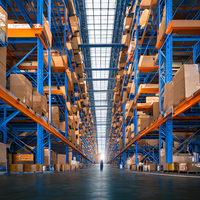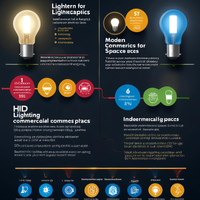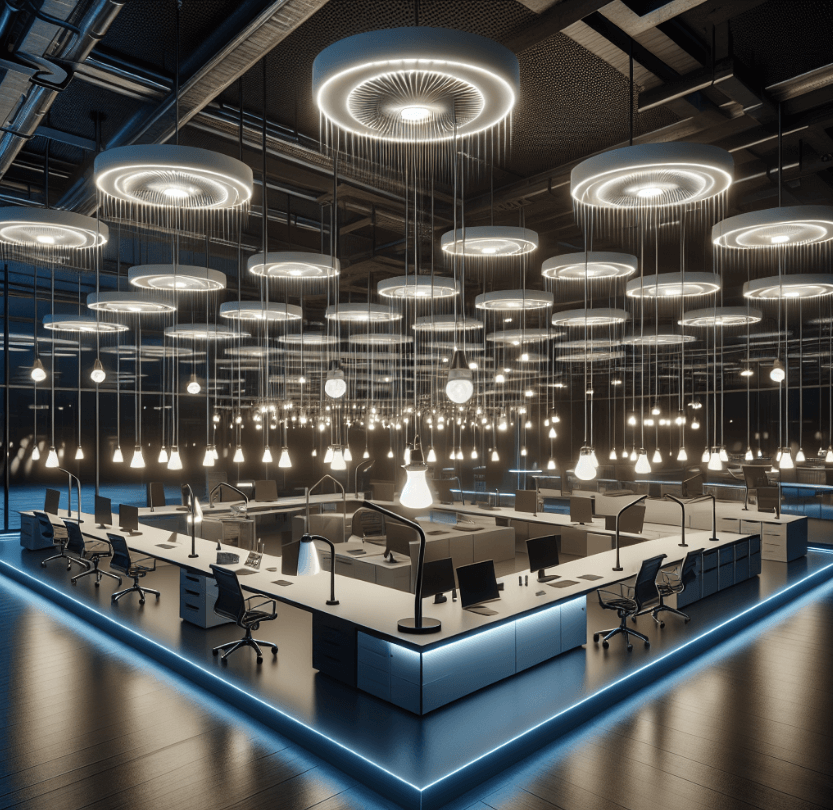Maximize LED Lifespan: End Early Burnouts!
If you're buying LED lights in bulk, you might have noticed they don't always last as long as they say on the box. That can be a big headache when you've got a lot of LED lights to deal with. This guide is here to help by pointing out some of the main reasons your LEDs might be giving up too soon. We'll go through easy-to-follow tips and fixes that can make your lights stick around longer. This way, when you buy a whole bunch of LEDs, you can feel confident they'll last like they're supposed to, saving you time and money.
Problem 1: Heat Generation and Dissipation
The Issue with Heat
LED lights create light, but in doing so, they also produce heat. Unlike old fashioned lights, LEDs aren't supposed to get too hot to touch. But sometimes, they do. Within an LED light, certain components are sensitive to high temperaturesIf these parts stay too warm for too long, they wear out faster, and your light won't last as long as it says on the package.
One reason LEDs can overheat is that they're in a spot without good airflow, like a tight recessed socket or a closed lampshade. Another reason might be that the light itself isn't made to handle the heat very well it doesn't have what it needs to cool down.
How to Fix It
Now, here’s how you can solve this problem:
- Give Them Space:Make sure your LED lights are in light fixtures that let air move freely around them. This airflow helps to carry away the heat from the light.
- Choose Wisely: When buying LED lights, especially in bulk, choose ones that mention 'heat sinks' or 'thermal management.' These lights are built to deal with heat better.
- Mind the Environment: Don't install LED lights in places that already get hot. For example, small enclosed spaces might not be the best choice because they trap heat, which can cause problems for the light.
By tackling these heat issues, you can help your LED lights work properly for a much longer time.
Problem 2: Poor Quality Components and Manufacturing
The Issue with Low-Quality Parts
When you buy LED fixtures like troffer lights, linear lights, or high bays in bulk, you expect them to work well for a long time. But sometimes, the internal parts aren't the best quality. This can include the chips that light up, the drivers that manage the power, or the capacitors that store the energy. If these parts are cheap, they may not last, which means your LED fixtures could stop working sooner than you'd expect.
Solutions to Consider
Here's what you can do to avoid this problem:
- Choose Reputable Manufacturers:Go for brands, like Halcon Lighting, that have a history of making good quality products. These companies usually invest in better parts for their LED fixtures, which means they might last longer.
- Look for Proof of Quality: There should be certifications on the products you're buying. These show that the fixtures have been tested and meet certain quality standards.
- Balance Cost with Quality: It's tempting to pick the cheapest option when buying lots of LED fixtures. However, paying a bit more for better quality can save you money down the line because you won't need to replace them as often.
By taking these steps, you'll be more likely to get LED fixtures that live up to their promised lifespan without unexpected failures.
Problem 3: Electrical Surges and Fluctuations
The Issue with Power Surges
LED fixtures can be sensitive to sudden increases in electricity, known as power surges. These surges can come from lightning strikes or equipment turning on and off in your building. They can damage the electronics inside your LED fixtures, leading to a shorter lifespan.
Solutions to Consider
To protect your LED lighting investments from these power issues:
- Use Surge Protectors: Install devices that guard against power surges in your electrical system. These can help shield your LED fixtures from sudden spikes in voltage that could cause harm.
- Look for Built-In Protection:When purchasing your LED fixtures, see if they come with built-in surge protection. Some products have this feature and it adds an extra layer of security for the fixtures.
- Be Mindful of Installation Areas:Avoid installing LED fixtures in places where you know power fluctuations are common. If that's not possible, additional protective measures should be taken to stabilize the power supply to the lights.
By taking these precautions, you can help ensure that unexpected changes in your electrical system don't cut short the life of your LED fixtures.
Problem 4: Voltage Inadequacy
The Issue with Incorrect Voltage
LED lighting options like panels, high bays, and LED strip lights all need the right voltage to operate efficiently. If the voltage in your electrical system is too high or too low for what these fixtures require, it can lead to problems.
High voltage can overload the LEDs, causing them to burn out quicker. Low voltage might mean the lights are dimmer than they should be or not working at all.
Solutions to Consider
Here's how you can ensure that voltage issues don't affect your LED lighting:
- Match Voltage Requirements:Check the voltage requirements of the LED fixtures—such as your vapor tight LED lights or LED ceiling linear grille lights—before installation to make sure they match your building's power supply.
- Install Voltage Regulators:If there's a chance that your power supply is unstable, using voltage regulators can help. These devices keep the voltage constant, which can be especially helpful for sensitive equipment like an LED troffer retrofit kit.
- Use Compatible Dimmers:When using dimmable fixtures like LED pendant lights or flush mounts, make sure the dimmers are compatible with LEDs. Some older dimmers may cause low voltage issues, so opt for LED-specific dimmers.
Taking these steps will help protect your LED fixtures from voltage related problems and ensure they perform well and last as long as they should.
Problem 5: Faulty Connections and Wiring
The Issue with Connection and Wiring Missteps
When there's something wrong with the electrical connections or wiring, it can lead to issues with all kinds of LED lights, from troffer lights to high bay lights, and from vapor tight fixtures to LED pendant lights. If the connections are loose or the wiring is old and unreliable, your LED fixtures may not work consistently. They might flicker, dim, or fail to turn on at all, which can significantly shorten their lifespan.
Solutions to Consider
To prevent these types of issues, here's what to do:
- Check and Secure Connections:Regularly inspect the connections where your LED fixtures, like light bars or LED wrap lights, are installed. Make sure they're tight and secure. This can help prevent problems related to loose connections.
- Update Old Wiring:If you're installing modern LED fixtures like LED strip lights or LED ceiling linear grille lights in an older building, the existing wiring might not be up to current standards. It could be wise to have a professional electrician replace or upgrade the wiring.
- Follow Installation Guidelines: When setting up any new LED fixtures, such as flush mounts or an LED linear light, always follow the manufacturer's guidelines for installation. Proper installation helps ensure that the fixture's connection to your power supply is solid and safe.
By addressing potential connection and wiring issues properly, you can improve the reliability of your LED lighting and ensure that they function correctly, reducing the need for replacements and maintenance over time.
Problem 6: Incompatible Control Systems
The Issue with Controls and Dimmers
LED lighting, which can range from sleek LED panels to robust high bays, often gets paired with control systems to manage brightness and power use. If these systems like dimmers or sensors are not compatible with your specific types of LED fixtures, such as vapor tight LEDs or LED linear lights, it can cause issues. Incompatible dimmers might lead to flickering in LED strip lights or even prevent LED ceiling linear grille lights from functioning correctly.
Solutions to Consider
To sidestep troubles with controls and dimmers, here's a game plan:
- Verify Compatibility:Before you purchase any dimmers or control systems for your LED lights, including troffer retrofit kits and light bars, make sure they are listed as compatible by the manufacturer. This information is usually available on the product packaging or the company's website.
- Use LED Specific Controls:Opt for control systems that are designed to work with LEDs. For example, if you’re installing flush mounts or LED wrap lights that you want to dim, look for LED rated dimmer switches that handle the lower wattage of LED lights without issues.
- Consult Professionals:When integrating more complex systems, like those controlling multiple LED pendant lights or an array of high bay fixtures, it might be best to consult with an electrical professional. They can recommend the best products for your setup and ensure proper installation and configuration.
By ensuring that all control systems are compatible with your LED fixtures, you'll help extend the life of your lights and maintain their performance and efficiency over time.
Problem 7: Inadequate Maintenance
The Issue with Lack of Upkeep
Proper maintenance is crucial for ensuring the longevity and performance of LED lighting solutions, including troffer lights, panels, and high bays. LED fixtures like vapor tight LED lights, LED wrap lights, and LED pendant lights are designed to be low maintenance, but they still require some attention. Dust buildup, for instance, can affect light output and heat dissipation. Neglecting regular cleaning and inspections can lead to a decrease in the efficiency and lifespan of your LED fixtures.
Solutions to Consider
To prevent problems caused by inadequate maintenance, here's what you should do:
- Regular Cleaning: Create a schedule to dust off and clean your LED fixtures routinely. For instance, linear lights and flush mounts can accumulate dust on their surfaces, which can dim the brightness. Use a soft cloth or a duster to gently clean the fixtures.
- Inspect Fixtures Periodically:Take time to inspect your LED installations, like LED strip lights and light bars, every few months. Check for signs of damage, wear, or loose connections that might need addressing.
- Replace as Needed:If any parts of your LED setup, such as an LED troffer retrofit kit or ceiling linear grille lights, start to show issues like flickering or dimming, it could be time to replace those components. Early replacement can prevent further problems or potential failures.
By implementing a routine maintenance plan, you ensure that each part of your LED lighting system, from high bay lights to LED panels, continues to operate at its best, reducing the likelihood of unexpected outages and costly downtimes.
Problem 8: Incorrect Installation
The Issue with Installation Errors
Even the best LED fixtures, whether they're robust high bays or sleek LED strip lights, can run into problems if they're not installed correctly. This is true for all types of LEDs, from vapor tight LED lights that need to be sealed properly to protect against moisture, to LED retrofit kits that must be fitted accurately to work with existing fixtures. An incorrect installation can lead to persistent operational issues such as flickering, reduced light output, or even premature failure.
Solutions to Consider
Here's how to avoid installation-related issues:
- Follow Manufacturer Instructions:Every type of LED light, like troffer lights or LED linear lights, comes with a set of manufacturer instructions. It's important to follow these closely during installation to ensure the fixture functions as intended.
- Use Qualified Electricians:For installations that are more complex or involve electrical knowledge beyond the basics — such as setting up LED pendant lights or connecting multiple light bars — it's best to hire a professional electrician. They have the expertise to handle the wiring and setup correctly.
- Double-Check Work: After installing any LED fixture, from flush mounts to LED ceiling linear grille lights, go through a checklist to make sure everything is in place. Check that all connections are secure, the power supply matches the product specifications, and that the fixtures are mounted firmly and safely.
Proper installation is key to getting the performance and longevity promised by your LED lighting. By ensuring that each step is carried out correctly, you'll minimize the risk of malfunctions and extend the lifespan of your fixtures.
Problem 9: Environmental Conditions Not Adhered To
The Issue with Ignoring Environmental Specifications
LED fixtures, including high bays for warehouses or vapor tight LED lights for damp locations, are engineered to operate within certain environmental conditions. When these fixtures, such as LED panels or flush mounts, are used in conditions they're not rated for for example, high humidity, extreme temperatures, or corrosive environments their performance can suffer. This can lead to reduced brightness, color shifting, and even complete failure of the fixture.
Solutions to Consider
To ensure that your LED lighting performs well regardless of where it's installed:
- Check Environmental Ratings:Before installing any type of LED light, like troffer lights or LED linear lights, verify their rating for use in specific conditions. Make sure they're suitable for the environment where they will be used, whether it's a cold storage facility or a covered outdoor patio.
- Choose Appropriate Fixtures: For areas prone to moisture or dust, select fixtures designed for those challenges, such as vapor tight LED lights or LED wrap lights with a higher Ingress Protection (IP) rating.
- Monitor Ambient Conditions: Keep an eye on the temperature and humidity levels in spaces lit by LED fixtures, especially if you're using sensitive products like LED strip lights or LED pendant lights. If environmental conditions change, you may need to adjust your lighting choices or add protective measures.
By taking into account the environmental specifications for your chosen LED fixtures, you can avoid many common issues caused by unsuitable conditions. This foresight helps maintain the quality and longevity of your LED lighting solutions like light bars and LED ceiling linear grille lights, ensuring they continue to illuminate effectively over time.
Save Money by Protecting Your LED Lights Today
For facility managers, electricians, and property owners looking to maximize their investment in LED lighting whether that's robust high bays in industrial settings or sleek panels in office spaces it's essential to take proactive steps. Choose the correct fixtures for specific environments, ensure they are installed correctly, protect them from electrical fluctuations, and keep up with maintenance. Additionally, pairing your LEDs with compatible controls and supplying them with the right voltage will play a significant role in maintaining their efficiency. By focusing on these straightforward strategies, you'll help extend the life of your LED lighting, which means fewer replacements, reduced costs, and better illumination where it counts.
Read related blog here:



